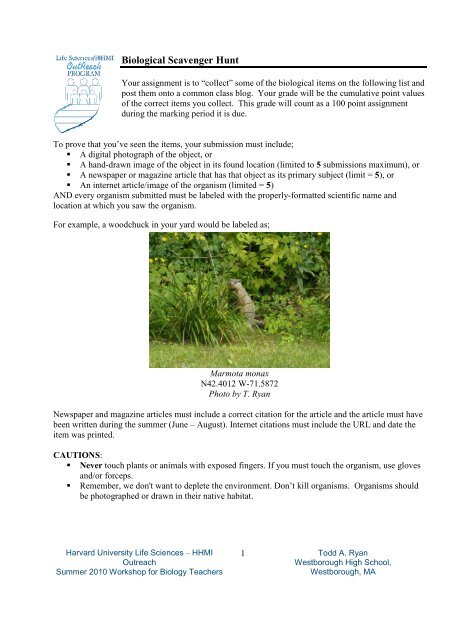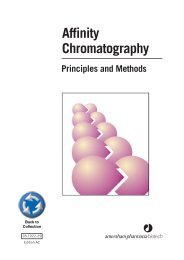Biological Scavenger Hunt - Life Sciences Outreach Program ...
Biological Scavenger Hunt - Life Sciences Outreach Program ...
Biological Scavenger Hunt - Life Sciences Outreach Program ...
Create successful ePaper yourself
Turn your PDF publications into a flip-book with our unique Google optimized e-Paper software.
<strong>Biological</strong> <strong>Scavenger</strong> <strong>Hunt</strong><br />
Your assignment is to “collect” some of the biological items on the following list and<br />
post them onto a common class blog. Your grade will be the cumulative point values<br />
of the correct items you collect. This grade will count as a 100 point assignment<br />
during the marking period it is due.<br />
To prove that you’ve seen the items, your submission must include;<br />
A digital photograph of the object, or<br />
A hand-drawn image of the object in its found location (limited to 5 submissions maximum), or<br />
A newspaper or magazine article that has that object as its primary subject (limit = 5), or<br />
An internet article/image of the organism (limited = 5)<br />
AND every organism submitted must be labeled with the properly-formatted scientific name and<br />
location at which you saw the organism.<br />
For example, a woodchuck in your yard would be labeled as;<br />
Marmota monax<br />
N42.4012 W-71.5872<br />
Photo by T. Ryan<br />
Newspaper and magazine articles must include a correct citation for the article and the article must have<br />
been written during the summer (June – August). Internet citations must include the URL and date the<br />
item was printed.<br />
CAUTIONS:<br />
Never touch plants or animals with exposed fingers. If you must touch the organism, use gloves<br />
and/or forceps.<br />
Remember, we don't want to deplete the environment. Don’t kill organisms. Organisms should<br />
be photographed or drawn in their native habitat.<br />
Harvard University <strong>Life</strong> <strong>Sciences</strong> – HHMI<br />
<strong>Outreach</strong><br />
Summer 2010 Workshop for Biology Teachers<br />
1 Todd A. Ryan<br />
Westborough High School,<br />
Westborough, MA
PUBLISHING THE PROJECT<br />
The project should be published on the class blog located at;<br />
http://BLOG_URL<br />
Once I receive an appropriate email from you, I’ll add you as an author to the blog and you can upload<br />
your items there. Alternatively, it can be submitted as a PowerPoint presentation (although you cannot<br />
earn the points for consecutive weeks of blog postings). A word of caution, many digital cameras will<br />
record HUGE picture files and a digital version of this project can become tremendously large. Limit<br />
the size of your photos if you are submitting this as a PowerPoint or you won’t be able to put the entire<br />
project on a single CD. There are freeware programs on the internet that will reduce the file size of your<br />
photos.<br />
In order to receive full credit for this project you must submit the attached completed logsheet by<br />
DATE. Your grade will be reduced by 5% for every school day (regardless of whether our class period<br />
meets or not). The scoring rubric is available as a download on Moodle.<br />
Identification of Species<br />
This will likely be one of the most challenging aspects of the project. The internet can be helpful as<br />
there are identification guides available online. The classification of many organisms is presented at the<br />
Encyclopedia of <strong>Life</strong> (www.eol.org). Many libraries also have field guides and most museums and zoos<br />
identify their organisms for you. You can also post questions on the class Moodle site and perhaps one<br />
of your colleagues will assist you in identification.<br />
Harvard University <strong>Life</strong> <strong>Sciences</strong> – HHMI<br />
<strong>Outreach</strong><br />
Summer 2010 Workshop for Biology Teachers<br />
2 Todd A. Ryan<br />
Westborough High School,<br />
Westborough, MA
Specimen List: Below are the items you are to “collect”. An individual organism (e.g. your pet cat) can<br />
only be used once although different individuals of that same species can be used as appropriate.<br />
Humans are acceptable for one category only. You may use internet-based images for no more than 5 of<br />
these items.<br />
LOCAL ORGANISMS: PROGRESSIVE POINT VALUES (maximum of 5 sets)<br />
The first organism in each category counts 1 pt, the second different type of organism is 2 additional pts<br />
(total 1 + 2 = 3), the third is 3 (6 pts total), etc up to a total of 5 organisms in the category. Every<br />
organism/example must be indigenous to Massachusetts.<br />
Different Biomes (only three must be within MA)<br />
Different carbohydrates<br />
Distinguishing characteristics between monocots and dicots<br />
Different classes of proteins<br />
Evidence of alleles for the same trait<br />
Organisms in different animal phyla<br />
Organisms in different kingdoms<br />
Organisms in different plant divisions<br />
Organisms in same class but different orders<br />
Organisms in same genus but with different species<br />
Organisms in same order but different family<br />
Organisms on different levels of the same food chain<br />
1,2,3,4,5 (max 15) <br />
1,2,3,4,5 (max 15) <br />
1,2,3,4,5 (max 15) <br />
1,2,3,4,5 (max 15) <br />
1,2,3,4,5 (max 15) <br />
1,2,3,4,5 (max 15) <br />
1,2,3,4,5 (max 15) <br />
1,2,3,4,5 (max 15) <br />
1,2,3,4,5 (max 15) <br />
1,2,3,4,5 (max 15) <br />
1,2,3,4,5 (max 15) <br />
1,2,3,4,5 (max 15) <br />
Harvard University <strong>Life</strong> <strong>Sciences</strong> – HHMI<br />
<strong>Outreach</strong><br />
Summer 2010 Workshop for Biology Teachers<br />
3 Todd A. Ryan<br />
Westborough High School,<br />
Westborough, MA
These do not need to be indigenous to Massachusetts (you may have up to two examples of each<br />
category; submitting more than two will not add any additional points).<br />
Altruistic Behavior (2)<br />
Mutualism (2)<br />
Amphibian (1)<br />
Nematode (1)<br />
An organism that cannot be classified<br />
Nonvascular plant (1)<br />
according to the “biological” species<br />
Organism’s home (1)<br />
concept (1)<br />
Parasitism (2)<br />
Analogous structures (2)<br />
Participation in a citizen science<br />
Angiosperm (1)<br />
experiment (2)<br />
Animal adaptation for a specific<br />
Passeriform (1)<br />
environment (2)<br />
Plant adaptation for a specific<br />
Animal larva or pupa (1)<br />
environment (2)<br />
Annelida (1)<br />
Plant reproductive structures (1)<br />
Arthropod (1)<br />
Plant using animals for seed dispersal (1)<br />
Asexual reproduction (1)<br />
Plant using either wind or water for seed<br />
Bilaterally symmetrical organism (1)<br />
dispersal (1)<br />
Biogeochemical cycle (3)<br />
Population (2)<br />
Bryophyte (1)<br />
Predation (2)<br />
C 3 and either C 4 or CAM organisms (2) Pterophyte (1)<br />
Commensalism (2)<br />
Radially symmetrical individual (1)<br />
Crustacean (1)<br />
Redox reaction (2)<br />
Detritivore (1)<br />
Secondary Succession (3)<br />
Dominant vs. recessive phenotypes (2) Sporophyte and gametophyte<br />
Endangered species (2)<br />
generations of the same plant (3)<br />
Endothermic organism (1)<br />
Storage polysaccharides (2)<br />
Energy transfers (1)<br />
Street/road sign with famous biologist’s<br />
Evidence of evolution (2)<br />
last name (1x per name) (1)<br />
Example of reproductive isolation (2)<br />
Taxis (biological; not automotive) (1)<br />
Exothermic organism (1)<br />
Territorial behavior (2)<br />
Fungal reproductive structures (1)<br />
Tropism (2)<br />
Genetic variation within a population<br />
Turgid versus flaccid organism (2)<br />
(2)<br />
Two morphologically distinct life stages<br />
Homeostasis of an organism (2)<br />
of the same organism (i.e., tadpole/frog<br />
Homologous structures (2)<br />
or caterpillar/butterfly) (2)<br />
Instinctual behavior (2)<br />
Venation patterns (palmate, pinnate and<br />
Interaction between science and<br />
parallel) (3)<br />
technology (1)<br />
Vestigial structure in an animal (2)<br />
Introduced species (1)<br />
Weekly submission of at least one item<br />
Lepidopteron (1)<br />
onto the class blog (1x only/1 pt per<br />
consecutive week)(a week is defined as<br />
Logging in to Moodle (1x only/1)<br />
starting on a Sun and ending on Sat)<br />
Mating behavior (2)<br />
Mollusk (1)<br />
Harvard University <strong>Life</strong> <strong>Sciences</strong> – HHMI<br />
<strong>Outreach</strong><br />
Summer 2010 Workshop for Biology Teachers<br />
4 Todd A. Ryan<br />
Westborough High School,<br />
Westborough, MA
Name: Date: Period:<br />
Summer <strong>Scavenger</strong> <strong>Hunt</strong> Logsheet<br />
Identify the organisms that are submitted in your project:<br />
ITEM<br />
Date(s) Posted to Blog:<br />
Different Biomes<br />
Different carbohydrates<br />
Distinguishing characteristics monocots / dicots<br />
Different classes of proteins<br />
Evidence of alleles for the same trait<br />
Organisms in different animal phyla<br />
Organisms in different kingdoms<br />
Organisms in different plant divisions<br />
Organisms in same class<br />
Organisms in same genus<br />
Organisms in same order<br />
Organisms of the same food chain<br />
Altruistic Behavior (2)<br />
Amphibian (1)<br />
Non-“biological” species concept (1)<br />
Analogous structures (2)<br />
Angiosperm (1)<br />
Animal adaptation (2)<br />
Animal larva or pupa (1)<br />
Annelida (1)<br />
Arthropod (1)<br />
Asexual reproduction (1)<br />
Bilaterally symmetrical organism (1)<br />
Biogeochemical cycle (3)<br />
Bryophyte (1)<br />
C3 and either C4 or CAM organisms (2)<br />
Commensalism (2)<br />
Crustacean (1)<br />
Detritivore (1)<br />
Dominant vs. recessive phenotypes (2)<br />
Endangered species (2)<br />
Endothermic organism (1)<br />
Energy transfers (1)<br />
Evidence of evolution (2)<br />
Example of reproductive isolation (2)<br />
Exothermic organism (1)<br />
Fungal reproductive structures (1)<br />
Genetic variation within a population (2)<br />
Homeostasis of an organism (2)<br />
Harvard University <strong>Life</strong> <strong>Sciences</strong> – HHMI<br />
<strong>Outreach</strong><br />
Summer 2010 Workshop for Biology Teachers<br />
5 Todd A. Ryan<br />
Westborough High School,<br />
Westborough, MA
Homologous structures (2)<br />
Instinctual behavior (2)<br />
Interaction between science/technology (1)<br />
Introduced species (1)<br />
Lepidopteron (1)<br />
Logging in to Moodle (1x only/1)<br />
Mating behavior (2)<br />
Mollusk (1)<br />
Mutualism (2)<br />
Nematode (1)<br />
Nonvascular plant (1)<br />
Organism’s home (1)<br />
Parasitism (2)<br />
citizen science experiment (2)<br />
Passeriform (1)<br />
Plant adaptation (2)<br />
Plant reproductive structures (1)<br />
Plant using animals for seed dispersal (1)<br />
Plant using wind/water for seed dispersal (1)<br />
Population (2)<br />
Predation (2)<br />
Pterophyte (1)<br />
Radially symmetrical individual (1)<br />
Redox reaction (2)<br />
Secondary Succession (3)<br />
Sporophyte and gametophyte generations (3)<br />
Storage polysaccharides (2)<br />
Street/road sign with biologist’s name (1)<br />
Taxis (biological; not automotive) (1)<br />
Territorial behavior (2)<br />
Tropism (2)<br />
Turgid versus flaccid organism (2)<br />
Two distinct life stages (2)<br />
Venation patterns (3)<br />
Vestigial structure in an animal (2)<br />
Harvard University <strong>Life</strong> <strong>Sciences</strong> – HHMI<br />
<strong>Outreach</strong><br />
Summer 2010 Workshop for Biology Teachers<br />
6 Todd A. Ryan<br />
Westborough High School,<br />
Westborough, MA

















